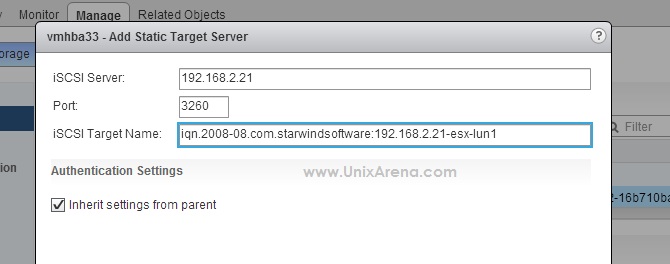

If you already had a session open to the iSCSI target prior to configuring port binding it may be necessary to perform a iSCSI re-login. Once all the required portgroups have been added, click ok then perform a rescan of the adapter.
Add iscsi to vmware esxi 5 software#
The port binding is set up under the Network Configuration options in the software iSCSI adapter’s properties: You can also change the name and define the targets using esxcli: esxcli iscsi adapter set -name :esx-host01-64ceae7s -A vmhba33 esxcli iscsi adapter discovery sendtarget add -a 10.10.10.1:3260 -A vmhba33 Configuring Multipathing for Software iSCSI The next step is to configure IP addresses of the iSCSI targets, either using Static or Dynamic discovery and CHAP authentication if required: Once enabled you can access the adaptors properties and change the initiator name if you choose to do so: If you prefer you can enable the adapter using esxcli by running: ~ # esxcli iscsi software set -e true Click Add, and select the iSCSI Storage Adapter: In the vSphere client, go to Configuration | Storage Adapters. Configure the iSCSI Software Adapterīefore you are able to configure the adapter, it will need to be enabled. Once that is done the network configuration will be complete and will match that shown in the vSphere client in the first example. ~ # esxcli network ip interface add -p ISCSI_2 -i vmk3 The last step is to create the VMkernel interfaces and association them with the portgroups we have just created: ~ # esxcli network ip interface add -p ISCSI_1 -i vmk1 ~ # esxcli network vswitch standard portgroup policy failover set -a vmnic3 -p ISCSI_2 The next step is to associate the uplinks/nics with the correct portgroups: ~ # esxcli network vswitch standard portgroup policy failover set -a vmnic1 -p ISCSI_1 Then make them active: # esxcli network vswitch standard policy failover set -a vmnic1,vmnic3 -v vSwitch1 ~ # esxcli network vswitch standard uplink add -u vmnic3 -v vSwitch1 Next we need to add the uplinks to the new vSwitch: ~ # esxcli network vswitch standard uplink add -u vmnic1 -v vSwitch1 ~ # esxcli network vswitch standard portgroup add -p ISCSI_2 -v vSwitch1 Once the switch is created we can create the new portgroups: ~ # esxcli network vswitch standard portgroup add -p ISCSI_1 -v vSwitch1 To create a new standard vSwitch run: esxcli network vswitch standard add -v vSwitch1 You can also complete the configuration steps above using esxcli. iSCSI Network Configuration Using the ESXCLI What we need to do is only have one adapter active for each portgroup, with the others being configured as unused:įor my other portgroup I set vmnic1 as the Active Adapter, with vmnic3 being set as Unused. My resulting configuration looked like this:īy default, all network adapters that were added to the vSwitch will be active for all portgroups: In my lab I used two nics so created two portgroups. The next step is to go into the settings of the new vSwitch and create additional portgroups for each nic you have assigned to the vSwitch.


There are a few things to bear in mind before configuring port binding: Prior to ESXi 5, port binding could only be configured using the CLI. With vSphere 5, iSCSI port binding can be configured in the vSphere client as well as the CLI. Port binding is used to provide multiple paths to an iSCSI array. By default, the default iSCSI configuration creates only one path to each iSCSI target.


 0 kommentar(er)
0 kommentar(er)
